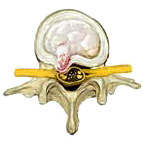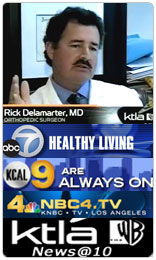Did you know?
If you can answer yes to any of the following questions, you should consult a spine specialist:- Has your low back pain extended down your leg?
- Does your leg pain increase if you lift your knee to your chest or bend over?
- Have you had severe back pain following a recent fall?
- Have you had significant back pain lasting for more than 3 weeks?
- Have you had back pain that becomes worse when you rest, or wakes you up at night?
- Do you have persistent bladder or bowel problems?
Health Facts

Back pain is often caused by obesity
Most people know that obesity contributes to the development of various diseases. However, did you know that obesity is a contributing factor to back pain? It is true. Being overweight or obese can significantly contribute to osteoporosis, osteoarthritis, rheumatoid arthritis, degenerative disc disease, spinal stenosis, and spondylolisthesis.
Additional Resources
- NOTE: This list provides links to external on-line resources. Each link will open a new browser window.
- North American Spine Society a non-profit corporation
- Cervical Spine Research Society
- Scoliosis Research Society
- The International Spine Intervention Society
- American Academy of Pain Medicine
- American Pain Society
- A-O North America
- American Academy of Physical Medicine and Rehabilitation
- American Academy of Orthopaedic Surgeons
- American Association of Neurological Surgeons
- Back.com
- Neck Reference
- iScoliosis


- Notice of Disclaimer for external resource links.
The Spine Institute does not support nor endorse any of the resources listed above. They are provided for informational purposes only, and is not a comprehensive list.
Popular subjects
DISC | research | DDD |surgeons | spine | HERNIATED | ARTIFICIAL nucleus | TRIALS | BACK PAIN | video | FUSION | laminectomy | conservative | TREATMENTS
Introduction to Herniated Discs
 A disc is composed of two parts: an outer rim of fibrous (tough) tissue surrounding an inner loose material.
A disc is composed of two parts: an outer rim of fibrous (tough) tissue surrounding an inner loose material.
When there is a break in the outer rim, the inner material can leak out of the disc space and enter the spinal canal where the disc material can compress nerve roots or the spinal cord.
Disc herniation is a common cause of leg and back pain.
Symptoms of a Herniated Disc
The first symptom is usually extreme, sudden pain. In most cases the bottom two discs in the spinal column are the ones that herniate, so the pain usually begins in the lower back. When they bulge, these two discs exert pressure on the sciatic nerve, causing sharp pain to shoot down the leg. Sciatica will affect as much as 40% of the adult population at some point in their lives.Herniated discs higher up in the spine can cause pain and weakness in the neck, shoulders, or arms.
Numbness
and tingling in twoes and fingers, as well as a loss of movement
or strength in any part of the body are also symptoms of a herniated
disc and could be a sign of a serious problem. It's important
to note that pain is often not a matter of a single defect.
The pain associated with disc herniation usually improves with lying
down and worsens with prolonged sitting/standing or walking. Rarely,
bowel or bladder problems and progressive neurological deficits (such
as weakness) may develop; this type of situation requires urgent surgical
decompression of the nerves under pressure.
A magnetic resonance image (MRI) is an excellent tool to diagnose a herniated disc. If previous surgery has been performed in the area, however, a special MRI with contrast, or a CT myelogram is the most effective way to evaluate the spine. X-rays are also routinely used to determine the bony anatomy and alignment of the spine.
Treatment Options for Disc Herniation
Because there are so many causes of a herniated disc (and all back pain for that matter), each patient commands a different treatment plan. The first approach we take with all our patients is conservative, with treatment consisting of exercise, physical therapy or medication (or a combination therof). The majority of back problems go away in four to six weeks with moderate medical attention and pain medication. For those who fail conservative treatment there are now new microsurgical techniques that can offer appreciable relief.Olympic Athelete has Herniated Disc Surgery (KCAL Ch9, Los Angeles, CA) (click on the image below to watch the video):
Most people have full recovery from episodes of sciatica within the first few weeks. If the symptoms continue past 6 weeks, however, one should consider undergoing an evaluation which includes MRI studies.
If symptoms continue and conservative management has not been helpful,
surgical decompression of the disc (microdiscectomy) may be helpful
in relieving the symptoms. The only absolute indications for surgery,
however, are progressive neurological symptoms, bowel or bladder problems,
and severe, unremitting pain.
- Medications (medicines are available to help control pain)
- Acupuncture (an adjunctive treatment for the relief of chronic or acute pain)
- Body Braces (a medical device designed to support the body and to correct spine curvature)
- Physical Therapy (therapist guides the exercise process, stretching the muscles along the spinal column while the patient is in the specified positions)
Surgical Treatments Options:
- Artificial Disc Replacement (total disc replacement)
- Spinal Fusion (remove the disc and fuse the vertebre together)
- Microendoscopic Discectomy (MED) (is performed by making a small incision in the patient's back and inserting a small endoscopic probe between the vertebrae)
- Laminaplasty (procedure is used to relieve spinal cord compression in the cervical spine)
Frequently Asked Questions about Disc Herniation
| Q: | What is a herniated disc? |
| A: | A disc is a small pad of elastic tissue located between each vertebra in the spinal column. Discs act as shock absorbers for the vertebrae and prevent them from rubbing against each other. Discs are held in place by thick ligaments attached to the vertebrae. Often, these discs break down, and bulge into the spinal canal, or the thick jellylike material inside them seeps out to press against a nerve. The result is what we commonly call a herniated or slipped disc. |
Q: |
What are the symptoms of a herniated disc? |
| A: | The first symptom is usually extreme, sudden pain. In most cases the bottom two discs in the spinal column are the ones that herniate, so the pain usually begins in the lower back. When they bulge, these two discs exert pressure on the sciatic nerve, causing sharp pain to shoot down the leg. Sciatica will affect as much as 40% of the adult population at some point in their lives. Herniated discs higher up in the spine can cause pain and weakness in the neck, shoulders, or arms. Numbness and tingling in twoes and fingers, as well as a loss of movement or strength in any part of the body are also symptoms of a herniated disc and could be a sign of a serious problem. It's important to note that pain is often not a matter of a single defect. |
Q: |
How does age affect a disc? |
| A: | The pulpy disc tissue degenerates naturally as we age. And, the supporting ligaments begin to weaken. At a younger age, a single excessive strain is usually the cause of injury to the disc. But as we get older and the wear and tear progresses, a relatively minor strain or twisting movement can cause a disc herniate. Although there are many causes for this wear and tear, the primary factor is genetics. Research has shown that there may be a hereditary predispoition for slipped discs, often with may members of a family being affected. |
Q: |
What other factors contribute to the degeneration process? |
| A: | Stress, tension, overweight, lack of exercise, poor sitting and working posture may aggravate an already existing back condition. The wear and tear of the disc is also spurred by disease such as cancer, rheumatoid arthritis, diabetes and certain medications. |
Q: |
When should people see a doctor? |
| A: | They should see a doctor if they suffer from back pain that is accompanied by pain that radiates down their leg or pain that does not seem to go away after a few days of rest. |
Q: |
When is surgery a good option for treating herniated discs? |
| A: | The human body has an amazing ability to heal even when battered by wear and tear. For most people, back pain can usually be eased with a few changes in lifestyle, mild physical therapy, back-strengthening exercises, behavior modification, and a little patience. The majority of back problems go away in four to six weeks with moderate medical attention and pain medication. In a few cases, when the pain is severe and does not respond to nonsurgical treatment, surgery to remove the bulging disc parts may be a good option. New microsurgery techniques now offer patients quicker recovery and more complete recovery than traditional surgery methods. |
Q: |
How are herniated discs treated? |
| A: | Because there are so many causes of a herniated disc (and all back pain for that matter), each patient commands a different treatment plan. The first approach we take with all our patients is conservative, with treatment consisting of exercise, physical therapy or medication (or a combination therof). The majority of back problems go away in four to six weeks with moderate medical attention and pain medication. For those who fail conservative treatment there are now new microsurgical techniques that can offer appreciable relief. |
Latest news
Visit our media library for access to all of our news videos.
The Spine Institute is often in the news pioneering new treatments to help the reported 34 million Americans 18 years and older who suffer lower back pain, and another 9 million who suffer neck pain. Watch the news coverage here.
